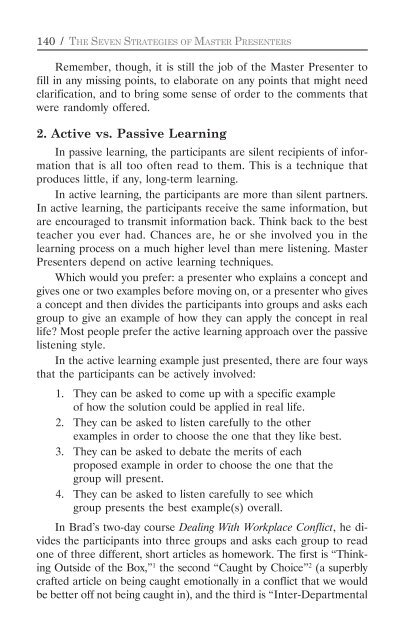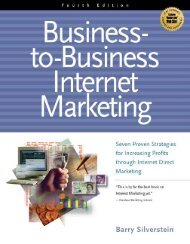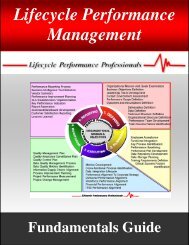The Seven Strategies of Master Presenters - Lifecycle Performance ...
The Seven Strategies of Master Presenters - Lifecycle Performance ...
The Seven Strategies of Master Presenters - Lifecycle Performance ...
You also want an ePaper? Increase the reach of your titles
YUMPU automatically turns print PDFs into web optimized ePapers that Google loves.
140 / THE SEVEN STRATEGIES OF MASTER PRESENTERS<br />
Remember, though, it is still the job <strong>of</strong> the <strong>Master</strong> Presenter to<br />
fill in any missing points, to elaborate on any points that might need<br />
clarification, and to bring some sense <strong>of</strong> order to the comments that<br />
were randomly <strong>of</strong>fered.<br />
2. Active vs. Passive Learning<br />
In passive learning, the participants are silent recipients <strong>of</strong> information<br />
that is all too <strong>of</strong>ten read to them. This is a technique that<br />
produces little, if any, long-term learning.<br />
In active learning, the participants are more than silent partners.<br />
In active learning, the participants receive the same information, but<br />
are encouraged to transmit information back. Think back to the best<br />
teacher you ever had. Chances are, he or she involved you in the<br />
learning process on a much higher level than mere listening. <strong>Master</strong><br />
<strong>Presenters</strong> depend on active learning techniques.<br />
Which would you prefer: a presenter who explains a concept and<br />
gives one or two examples before moving on, or a presenter who gives<br />
a concept and then divides the participants into groups and asks each<br />
group to give an example <strong>of</strong> how they can apply the concept in real<br />
life? Most people prefer the active learning approach over the passive<br />
listening style.<br />
In the active learning example just presented, there are four ways<br />
that the participants can be actively involved:<br />
1. <strong>The</strong>y can be asked to come up with a specific example<br />
<strong>of</strong> how the solution could be applied in real life.<br />
2. <strong>The</strong>y can be asked to listen carefully to the other<br />
examples in order to choose the one that they like best.<br />
3. <strong>The</strong>y can be asked to debate the merits <strong>of</strong> each<br />
proposed example in order to choose the one that the<br />
group will present.<br />
4. <strong>The</strong>y can be asked to listen carefully to see which<br />
group presents the best example(s) overall.<br />
In Brad’s two-day course Dealing With Workplace Conflict, he divides<br />
the participants into three groups and asks each group to read<br />
one <strong>of</strong> three different, short articles as homework. <strong>The</strong> first is “Thinking<br />
Outside <strong>of</strong> the Box,” 1 the second “Caught by Choice” 2 (a superbly<br />
crafted article on being caught emotionally in a conflict that we would<br />
be better <strong>of</strong>f not being caught in), and the third is “Inter-Departmental










